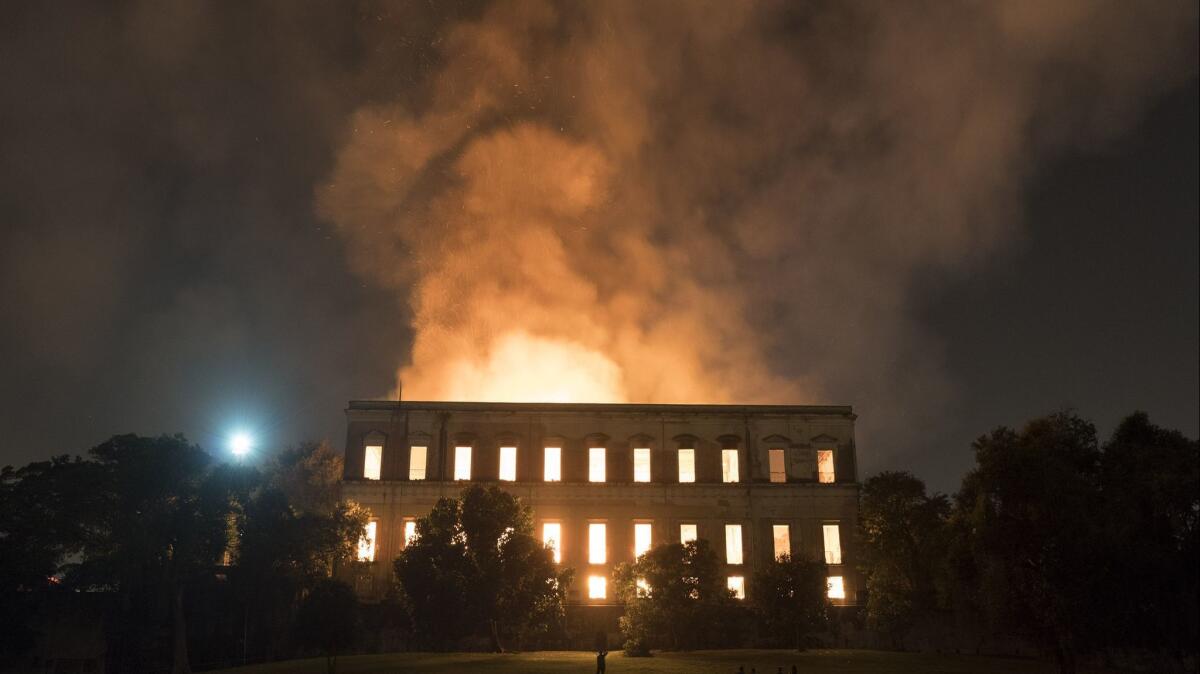Op-Ed: Think the museum fire in Brazil can’t happen here? Think again

- Share via
When a fire consumed Brazil’s National Museum on Sunday night, American museums followed the news closely. Images circulating on Twitter showed the stately building engulfed in flames as staff scrambled to save what specimens they could carry.
It will likely be weeks before we know exactly what was lost from the Museu Nacional in Rio de Janeiro, the equivalent of our Smithsonian. But the initial assessment is bleak: nearly all 5 million specimens in the insect collection, as well as the museum’s historical and sociological archives, which housed recordings of now-extinct languages.
For the record:
12:30 p.m. Sept. 10, 2018This story originally suggested that the American Museum of Natural History’s Dinosaur Hall chose to hedge its message on climate change as a result of funding it received from the Koch brothers. Actually, its hedge on climate change preceded the Koch funding.
This kind of disaster is every museum worker’s worst nightmare. Though the cause of the fire is not yet known, Brazilian academics were quick to point out that the museum had been woefully underfunded in recent years and that the risk of fire was well known. The museum’s budget was so meager, in fact, that its fire hydrants didn’t work. Firefighters had to carry water from a nearby lake.
Americans might be inclined to think: Well, that’s Brazil, a country whose economy is in free-fall. But this would be false security. The infrastructure of our public museums is crumbling too.
Data compiled in 2012 by the American Assn. of Museums found that, since 1989, public funding of museums in the U.S. declined from 38% of total budgets to 24%. And now the Trump administration is seeking to turn this slow death into a bloodletting.
If this tragic event can teach us anything, it’s that we must reinvest in our public museums.
The administration has proposed eliminating funding for the Institute of Museum and Library Services, which provides a significant amount of this federal financing. It has also proposed defunding the Biological Survey Unit, whose staff will soon be prohibited from curating 1 million of the specimens in the Smithsonian’s National Museum of Natural History.
This is a recipe for the kind of catastrophe that took place in Brazil. After years of paltry funding, one rare accident can easily become a disaster.
Researchers have observed firsthand the results of poor funding at our public museums: cramped and dilapidated specimen cases, outbreaks of pests, spotty digital records. The heroic efforts of museum staff notwithstanding, there are simply too few of them to ward off natural decay.
Generous investments are still made on an individual basis, such as the recent gift of $160 million to Yale’s Peabody Museum. But often such gifts come from private donors and are given to private museums. For every Peabody Museum, there are numerous public institutions like the San Bernardino County Museum, whose unheralded but important collections have faced consecutive budget cuts over the last decade and are overseen by a dwindling staff.
Public museums have been urged to “get creative” with their fundraising. This can mean shifting the focus from research, which costs money, to “earned income,” a strange turn of phrase that means entrance fees for public exhibits. The term also seems to imply that if a museum is not selling something, it’s just loafing around. Exhibits are important for teaching and engaging the public, but their capacity to inspire multiplies when informed by active research.
Another way to “get creative” is to shift from public to private funding. But private funding often comes with strings attached.
One-donor museums, which some call “egoseums,” are also in fashion. Their exhibits and research objectives, if they have any, often don’t serve the public and instead reflect the biases and blind spots of the 1%.
An additional problem with relying on private donors is that investing in infrastructure isn’t sexy. Solid infrastructure doesn’t generate press releases. Quite understandably, donors aren’t lining up to slap their names on sprinkler systems. Building something shiny and new usually wins out over an economical refurbishing.
When my colleagues and I were fundraising for a $13-million remodel of our building and collection space at Occidental College, we discovered that it was harder to raise $10,000 for a single part-time staff position than it was to raise $1 million for new exhibit spaces.
It is fortunate that no human life was lost in Brazil’s museum fire. But if this tragic event can teach us anything, it’s that we must reinvest in our public museums. We can’t rely solely on angel donors and staff heroics.
Museums inspire the public and house our knowledge bank. Their collections contain solutions to some of our most pressing problems and answers to questions that have yet to be asked. They are venerable, but surprisingly vulnerable. Without investment, they could go up in smoke.
John McCormack is an associate professor in biology at Occidental College and the director and curator of its Moore Laboratory of Zoology, which houses the largest Mexican bird collection in the world.
Enter the Fray: First takes on the news of the minute from L.A. Times Opinion »
Follow the Opinion section on Twitter @latimesopinion or Facebook
More to Read
A cure for the common opinion
Get thought-provoking perspectives with our weekly newsletter.
You may occasionally receive promotional content from the Los Angeles Times.










